|
|
|
Grand Prix del Verano 2005
Spanish Domestic Series
Presenter / Commentator:
Ramón García
Co-Presenters:
María Rodríguez
Vanesa Rubio
Referees:
Roberto Gil
Brandy Rodríguez
Raúl Rubio
Diego Serrano
Team Helpers:
Manuel Fonseca
Héctor del Moral
David Pérez
Jaime Rodríguez
Music:
Danilo Vaona
Dancers:
Miryam Brito
Susana Cantos
Eva Castañeda
Susana Cores
Mónica Corrales
Susana Costales
Gema González
Yaiza Guimaré
Susana Marca
Laura Mezcua
Elena de Miguel
Ana Isabel Peralta
Noemí Ramal
María Rayo
Production Credits:
Creator:
Francesco Boserman
Produced by:
Europroducciones TV for Televisión Española (TVE - E)
|
Key:
Grand Prix del Verano
●
= Heat Winner
●
= Qualified for Final
Final
●
=
Gold Trophy /
●
=
Silver Trophy
▲ = Promoted to Position / ▼ =
Demoted to Position |
|
|
E |
Grand Prix del Verano
2005 |
Heat 1 |
|
Event Staged: Summer 2005
Venue:
Estudio L-3 (Studio L-3), Estudios Buñuel (Buñuel Studios),
Avenida de Burgos, Chamartín, Madrid, Spain
European Transmissions (Local Timings):
TVE La 1 (E): Wednesday 15th June 2005
Audience Figures:
TVE La 1 (E): 2,326,000 viewers / 14.9% share |
|
Teams:
El Berrueco (Madrid) v. Minglanilla (Cuenca) |
|
Team
Members included:
El Berrueco (Madrid) - Coral Bistuer (Team Patron);
Minglanilla (Cuenca) - Eva González (Team Patron). |
|
Game
Results and Standings |
|
Result |
Team |
Points |
Final Scoreboard |
|
1st
2nd |
Minglanilla (Cuenca)
●
El Berrueco (Madrid) |
17
15 |
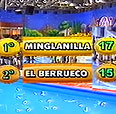 |
|
The Host
Town |
|
Madrid, Spain
Madrid is the capital city of Spain with a permanent population of around
3.3
million inhabitants, which makes it the second most populous city in the
European Union, surpassed only by Berlin in Germany, and the largest in Spain.
It is both the capital city of the Comunidad de Madrid (Community of Madrid)
and of the country of Spain, and is the seat of government, the residence of
the Spanish monarch, and is recognised as the political, economic and cultural
centre of the country. It is located 302.4km (187.9 miles) north-west of
Valencia, 391.3km (243.1 miles) north east of Sevilla, 274.2km (170.3 miles)
south west of Zaragoza and 176.1km (109.4 miles) south east of Salamanca.
Madrid is situated on the southern Meseta Central plateau, 60km south of the
Guadarrama mountain range and straddles the Jarama and Manzanares river
sub-drainage basins, in the wider Tagus River catchment area.
The Madrid area has been settled since the Stone Age and signs
remains of Lower Paleolithic human habitation, as well as Roman,
Visigoth and Muslim civilisations. Numerous ancient objects have been uncovered
in excavations along the banks of the River Manzanares, such as axes and the
remains of large mammals.
Originally named Mayrit, the city of Madrid was founded by the
emir Muhammad I of Córdoba towards the end of the ninth century and came to
prominence during the Arab occupation of the Iberian peninsula. The Emir built
a fortress on a headland near the river Manzanares, one of many built on the
border between Al-Andalus and the kingdoms of Leon and Castile, his objectives
being to protect the Toledo region from Christian invasion and also to
establish a base for Muslim offensives.
After the defeat of Toledo to Alfonso VI of Leon, the city was
conquered by Christians in 1085 during the Reconquista (Reconquest of Spain),
becoming a Crown property of the kingdom of Castile. Following the conquest,
Christians replaced Muslims in the occupation of the centre of the city, while
Muslims and Jews settled in the suburbs and all prevalent symbols of Muslim
influence and rule were removed. However, the events of this period produced a
cultural melting pot which still characterises the city today.
The 1123 Charter of Otorgamiento established the first
explicit limits between Madrid and Segovia, namely the Puerto de El Berrueco
and the Puerto de Lozoya, and in 1188, Madrid won the right to be a city with
representation in the courts of Castile. In 1202, Alfonso VIII of Castile gave
Madrid its first charter to regulate the municipal council, which was expanded
in 1222 by Ferdinand III of Castile. In 1329, King Fernando V assembled the famed Court
of Madrid for the first time. This augured in one of the darker periods in
Spanish history, namely the Spanish Inquisition. In the 14th and 15th
centuries, in the wake of the Reconquista, Moors and Jews banded together and
formed a concentrated population in Madrid – named Moreria to this day. In
1494 they were all denounced as “unbelievers” and expelled from Spain. Mosques
and other Muslim imagery once again disappeared from the area.
However it was not until the 16th century that Madrid became
Spain's capital city. King Felipe II moved the Imperial Court to Madrid in
1561, and from this time Madrid was now the kingdom's capital, apart from the
brief years between 1601 and 1606 when Felipe III installed his court in
Valladolid.
Madrid enjoyed significant changes during the 18th century,
when city gates, bridges and new buildings gave it a new appearance. The Royal
Palace (also called the Eastern Palace - Palacio de Oriente, standing next to
the large Plaza de Oriente square) was constructed on the site of the ruins of
the Alcazar or old Moorish Castle which had been destroyed by fire in 1734.
After 1738 Juan B. Sachetti directed the construction work on the Palace,
helped out to some extent by Ventura Rodríguez and developing on original
plans made by Juavera. The work on the Royal Palace was completed during the
reign of Carlos III (1759-1788), as was the construction of the city gates,
the Royal Theatre, the building that now houses the Ministry of Finance
(Hacienda), the Natural Science Museum, the Botanical Gardens and the temple
of San Francisco El Grande, amongst others. Also, the Retiro Park was
significantly improved and several new buildings built: Casa de Cisneros, the
General Hospital, the College of San Carlos, the Royal Mint, Casa de los
Geranios and the fountains of Cibeles, Neptune and Apollo.
On 27th October 1807, Charles IV and Napoleon I signed the Treaty of
Fontainebleau, which permitted French troops to pass through Spanish
territory to join the Spanish troops and invade Portugal, which had defied an
international blockade against England. As this was happening, there was the
Mutiny of Aranjuez (17th March 1808), by which the crown prince, Ferdinand
VII, replaced his father as king. However, Joachim-Napoléon Murat, a Marshal
of the French Empire, took advantage of the weakness of the Spanish Bourbons,
and forced both father and son, to join him in Bayonne in late April. In the
absence of the two kings, the situation became more and more tense in Madrid.
On 2nd May, a crowd gathered at the Royal Palace and set upon the French
soldiers there. The fight lasted for many hours and spread throughout Madrid.
The subsequent repression by the French was brutal. In the Paseo del Prado and
in the fields of La Moncloa hundreds of patriots were shot due to Murat's
order against "All Spaniards carrying arms". Paintings such as The Third of
May 1808 by Goya reflect the repression that ended the popular uprising on
2nd May. This proved to be the beginning of the War of Independence, a
large-scale war in which the Spanish fought against Napoleon and their former
allies in France, which has given rise to a number of patriotic memorials in
the city of Madrid. The Plaza Dos de Mayo is the most famous of these. In
1835, the world-famous University of Alcala de Henares was transferred to
Madrid. The Faculty of Science was added to it, and the academy became the
Universidad Complutense de Madrid (UCM).
During the Spanish Civil War (1936-1939), Madrid was held by
forces loyal to the Spanish Republic. Following the advance towards Madrid of
rebel land troops, the first air bombings on the city started on the night of
the 27th-28th August 1936, leaving it with the dubious honour of being the
first major European city to be bombed by aviation. The summer and autumn of
1936 saw the Republican Madrid witness heavy-handed repression by Communist
and Socialist groups, symbolised by the horrific Paracuellos massacres during
a major rebel offensive against the city, which was halted by early December.
Even towards the end of the war, Madrid witnessed great suffering and even a
minor civil war that accounted for roughly 2,000 lives between 5th and 10th
March 1939. The city fell to the nationalists on 28th March 1939 and,
following the onset of the Françoist dictatorship in the city, the absence of
freedoms and the brutal repression of those linked to a republican past
greatly affected life in the city. There was a climate of general shortage,
with ration coupons rampant and a lingering autocratic economy which lasted
until the mid-1950s.
After centuries of historical tumult, Madrid has made
tremendous urban progress in recent years. It is considered one of Europe’s
most progressive, modern and beautiful cities. It has a vibrant local arts
culture and boisterous nightlife, along with constant reminders of the city’s
rich history. It is deservedly renowned as one of the continent’s most
favoured tourist destinations. |
|
The Venue |
|
Estudios Buñuel
(Buñuel Studios)
The
games were played inside Studio L-3 at the RTVE's Estudios Buñuel (Buñuel
Studios). The studio facility stood on the site of the famous Estudios de
Chamartín, a film studio complex on Avenida De Burgos in Chamartín de la Rosa,
Madrid. Construction work commenced in 1935, working to designs by the notable
modernist architect Rafael Bergamín, but works were ceased during the Spanish
Civil War (1936-1939). Once the conflict was over, the construction was
completed, with the studios being officially inaugurated on 17th April 1941.
It was the third largest film studio in Madrid after those of CEA and Sevilla
Films and employed 255 people.
The
studio came to real prominence in the 1950s when it started to regularly host
the production of high profile international films in its studios and outdoor
spaces for standing sets. The first such co-production filmed there was
Captain Blackjack in 1950. By 1955 and the film La Gata, the studio
was equipped to make CinemaScope films. Consequently, the studio was
subsequently used for blockbusters like El Cid (1961) and 55 Days at
Peking (1963). Following the end of principal photography on the latter
film in 1962 the Chamartín complex was purchased by film mogul D. Samuel
Bronston, who reputedly paid the princely sum of 80 million pesetas to close
the deal and changed the studio name to Bronston Studios. However, by the
mid-1960s, the bubble burst for Bronston and his company - Bronston Española,
S.A. - when the blockbuster The Fall of the Roman Empire (1964) proved
to be an over-expensive flop at the box office. The company collapsed, but the
studios survived this shock to fight another day, finally closing in 1984.
After many years laying dormant, the site was purchased by
Radio and Televisión Española (RTVE), who redeveloped and renovated the old
Chamartín complex, reopening it on 12th September 1988 as Estudios Buñuel, a
three-studio modern television production facility. Studios L-1 and L-2 each
had a ground space of 600m², while L-3 was at the time of construction the
largest in Europe at 2,500m².
Many popular Spanish television programmes were made at the
studios. One of the first of these was Con las manos en la masa
(Red-Handed) and in 1992 it was where a major production of El Quijote
(Don Quixote) was made. It was well-established by the time Grand Prix del
Verano was recorded there between 2002 and 2005.
The studios were closed in November 2014 after TVE sold the
Estudios Buñuel complex to real estate company Pryconsa for 35.27 million
euros. TVE's decision to sell the studios was the result of a sustainability
study that recommended their productions all moved under one roof at their
Prado del Rey studios in another part of Madrid. The Buñuel Studios buildings
were demolished in 2015 and the site is now given over to newly-built luxury
apartments. |
|
Made
in Colour • This programme may exist in Spanish Archives |
|
|
|
E |
Grand Prix del Verano
2005 |
Heat 2 |
|
Event Staged: Summer 2005
Venue:
Estudio L-3 (Studio L-3), Estudios Buñuel (Buñuel Studios),
Avenida de Burgos, Chamartín, Madrid, Spain
European Transmissions (Local Timings):
TVE La 1 (E): Wednesday 22nd June 2005
Audience Figures:
TVE La 1 (E): 2,012,000 viewers / 14.2% share |
|
Teams:
Alburquerque (Badajoz) v. Ribera Alta (Álava) |
|
Team
Members included:
Alburquerque (Badajoz) - Patricia Conde (Team Patron);
Ribera Alta (Álava) - Gervasio Deferr (Team Patron). |
|
Game
Results and Standings |
|
Result |
Team |
Points |
Final Scoreboard |
|
1st
2nd |
Ribera Alta (Álava)
● ●
Alburquerque (Badajoz) |
30
15 |
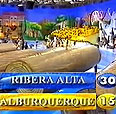 |
|
Made
in Colour • This programme may exist in Spanish Archives |
|
|
|
E |
Grand Prix del Verano
2005 |
Heat 3 |
|
Event Staged: Summer 2005
Venue:
Estudio L-3 (Studio L-3), Estudios Buñuel (Buñuel Studios),
Avenida de Burgos, Chamartín, Madrid, Spain
European Transmissions (Local Timings):
TVE La 1 (E): Wednesday 29th June 2005
Audience Figures:
TVE La 1 (E): 2,149,000 viewers / 14.6% share |
|
Teams:
Picón (Ciudad Real) v. Villanueva del Trabuco (Málaga) |
|
Team
Members included:
Picón (Ciudad Real) - Elsa Anka (Team Patron);
Villanueva del Trabuco (Málaga) - David Civera (Team Patron). |
|
Game
Results and Standings |
|
Result |
Team |
Points |
Final Scoreboard |
|
1st
2nd |
Picón
(Ciudad Real)
●
Villanueva del Trabuco (Málaga) |
29
16 |
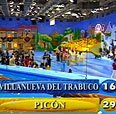 |
|
Made
in Colour • This programme may exist in Spanish Archives |
|
|
|
E |
Grand Prix del Verano
2005 |
Heat 4 |
|
Event Staged: Summer 2005
Venue:
Estudio L-3 (Studio L-3), Estudios Buñuel (Buñuel Studios),
Avenida de Burgos, Chamartín, Madrid, Spain
European Transmissions (Local Timings):
TVE La 1 (E): Wednesday 6th July 2005
Audience Figures:
TVE La 1 (E): 2,084,000 viewers / 16.0% share |
|
Teams:
Abades (Segovia) v. Cadreita (Navarra) |
|
Team
Members included:
Abades (Segovia) - Mónica Pont (Team Patron);
Cadreita (Navarra) - Sofía Mazagatos (Team Patron). |
|
Game
Results and Standings |
|
Result |
Team |
Points |
Final Scoreboard |
|
1st
2nd |
Cadreita
(Navarra)
●
Abades
(Segovia) |
29
28 |
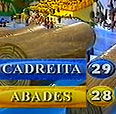 |
|
Made
in Colour • This programme may exist in Spanish Archives |
|
|
|
E |
Grand Prix del Verano
2005 |
Heat 5 |
|
Event Staged: Summer 2005
Venue:
Estudio L-3 (Studio L-3), Estudios Buñuel (Buñuel Studios),
Avenida de Burgos, Chamartín, Madrid, Spain
European Transmissions (Local Timings):
TVE La 1 (E): Wednesday 13th July 2005
Audience Figures:
TVE La 1 (E): 2,357,000 viewers / 19.3% share |
|
Teams:
Colindres (Cantabria) v. Frailes (Jaén) |
|
Team
Members included:
Colindres (Cantabria) - Santiago Urrialde (Team Patron);
Frailes (Jaén) - Verónica Mengod (Team Patron). |
|
Game
Results and Standings |
|
Result |
Team |
Points |
Final Scoreboard |
|
1st
2nd |
Colindres
(Cantabria)
●
Frailes (Jaén) |
24
21 |
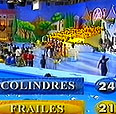 |
|
Made
in Colour • This programme may exist in Spanish Archives |
|
|
|
E |
Grand Prix del Verano
2005 |
Heat 6 |
|
Event Staged: Summer 2005
Venue:
Estudio L-3 (Studio L-3), Estudios Buñuel (Buñuel Studios),
Avenida de Burgos, Chamartín, Madrid, Spain
European Transmissions (Local Timings):
TVE La 1 (E): Wednesday 20th July 2005
Audience Figures:
TVE La 1 (E): 2,357,000 viewers / 19.6% share |
|
Teams:
A Merca (Orense) v. San Vicente de la Sonsierra (La Rioja) |
|
Team
Members included:
A Merca (Orense) - Eugenia Santana (Team Patron);
San Vicente de la Sonsierra (La Rioja) - Vanessa Romero (Team Patron). |
|
Game
Results and Standings |
|
Result |
Team |
Points |
Final Scoreboard |
|
1st
2nd |
San
Vicente de la Sonsierra (La Rioja)
●
A Merca (Orense) |
22
10 |
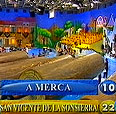 |
|
Made
in Colour • This programme may exist in Spanish Archives |
|
|
|
E |
Grand Prix del Verano
2005 |
Heat 7 |
|
Event Staged: Summer 2005
Venue:
Estudio L-3 (Studio L-3), Estudios Buñuel (Buñuel Studios),
Avenida de Burgos, Chamartín, Madrid, Spain
European Transmissions (Local Timings):
TVE La 1 (E): Wednesday 27th July 2005
Audience Figures:
TVE La 1 (E): 2,359,000 viewers / 19.7% share |
|
Teams:
Buenavista del Norte (Tenerife) v. La Fueva (Huesca) |
|
Team
Members included:
Buenavista del Norte (Tenerife) - Loreto Valverde (Team Patron);
La Fueva (Huesca) - Aarón Guerrero (Team Patron). |
|
Game
Results and Standings |
|
Result |
Team |
Points |
Final Scoreboard |
|
1st
2nd |
La
Fueva (Huesca)
●
Buenavista del Norte (Tenerife) |
24
21 |
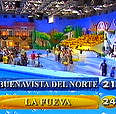 |
|
Made
in Colour • This programme may exist in Spanish Archives |
|
|
|
E |
Grand Prix del Verano
2005 |
Heat 8 |
|
Event Staged: Summer 2005
Venue:
Estudio L-3 (Studio L-3), Estudios Buñuel (Buñuel Studios),
Avenida de Burgos, Chamartín, Madrid, Spain
European Transmissions (Local Timings):
TVE La 1 (E): Wednesday 3rd August 2005
Audience Figures:
TVE La 1 (E): 2,246,000 viewers / 20.3% share |
|
Teams:
Porreres (Mallorca) v. San Fulgencio (Alicante) |
|
Team
Members included:
Porreres (Mallorca) - Alejandra Prat (Team Patron);
San Fulgencio (Alicante) - David Meca (Team Patron). |
|
Game
Results and Standings |
|
Result |
Team |
Points |
Final Scoreboard |
|
1st
2nd |
Porreres
(Mallorca)
●
San Fulgencio (Alicante) |
28
24 |
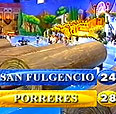 |
|
Made
in Colour • This programme may exist in Spanish Archives |
|
|
|
E |
Grand Prix del Verano
2005 |
Heat 9 |
|
Event Staged: Summer 2005
Venue:
Estudio L-3 (Studio L-3), Estudios Buñuel (Buñuel Studios),
Avenida de Burgos, Chamartín, Madrid, Spain
European Transmissions (Local Timings):
TVE La 1 (E): Wednesday 10th August 2005
Audience Figures:
TVE La 1 (E): 2,317,000 viewers / 21.8% share |
|
Teams:
Abarán (Murcia) v. Valderredible (Cantabria) |
|
Team
Members included:
Abarán (Murcia) - Lorena Bernal (Team Patron);
Valderredible (Cantabria) - Jorge Blass (Team Patron). |
|
Game
Results and Standings |
|
Result |
Team |
Points |
Final Scoreboard |
|
1st
2nd |
Valderredible
(Cantabria)
●
Abarán (Murcia) |
15
12 |
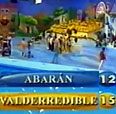 |
|
Made
in Colour • This programme may exist in Spanish Archives |
|
|
|
E |
Grand Prix del Verano
2005 |
Heat 10 |
|
Event Staged: Summer 2005
Venue:
Estudio L-3 (Studio L-3), Estudios Buñuel (Buñuel Studios),
Avenida de Burgos, Chamartín, Madrid, Spain
European Transmissions (Local Timings):
TVE La 1 (E): Wednesday 24th August 2005
Audience Figures:
TVE La 1 (E): 1,923,000 viewers / 18.0% share |
|
Teams:
Carrión de los Condes (Palencia) v. Montgat (Barcelona) |
|
Team
Members included:
Carrión de los Condes (Palencia) - Concha Galán (Team Patron);
Montgat (Barcelona) - Yvonne Reyes (Team Patron). |
|
Game
Results and Standings |
|
Result |
Team |
Points |
Final Scoreboard |
|
1st
2nd |
Carrión
de los Condes (Palencia)
● ●
Montgat (Barcelona) |
35
11 |
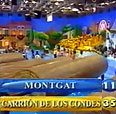 |
|
Made
in Colour • This programme may exist in Spanish Archives |
|
|
|
E |
Grand Prix del Verano
2005 |
Heat 11 |
|
Event Staged: Summer 2005
Venue:
Estudio L-3 (Studio L-3), Estudios Buñuel (Buñuel Studios),
Avenida de Burgos, Chamartín, Madrid, Spain
European Transmissions (Local Timings):
TVE La 1 (E): Wednesday 31st August 2005
Audience Figures:
TVE La 1 (E): 2,341,000 viewers / 19.6% share |
|
Teams:
Corvera de Asturias (Asturias) v. El Toro (Castellón) |
|
Team
Members included:
Corvera de Asturias (Asturias) - María José Suárez (Team Patron);
El Toro (Castellón) - Carlos Castel (Team Patron). |
|
Game
Results and Standings |
|
Result |
Team |
Points |
Final Scoreboard |
|
1st
2nd |
Corvera
de Asturias (Asturias)
●
El Toro (Castellón) |
19
14 |
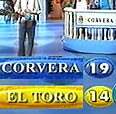 |
|
Made
in Colour • This programme may exist in Spanish Archives |
|
|
|
E |
Grand Prix del Verano
2005 |
Heat 12 |
|
Event Staged: Summer 2005
Venue:
Estudio L-3 (Studio L-3), Estudios Buñuel (Buñuel Studios),
Avenida de Burgos, Chamartín, Madrid, Spain
European Transmissions (Local Timings):
TVE La 1 (E): Sunday 4th September 2005
Audience Figures:
TVE La 1 (E): 1,138,000 viewers / 14.8% share |
|
Teams:
Aliseda (Cáceres) v. Daroca (Zaragoza) |
|
Team
Members included:
Aliseda (Cáceres) - Fernando Romay (Team Patron);
Daroca (Zaragoza) - Lucía Hoyos (Team Patron). |
|
Game
Results and Standings |
|
Result |
Team |
Points |
Final Scoreboard |
|
1st
2nd |
Daroca
(Zaragoza)
●
Aliseda (Cáceres) |
22
12 |
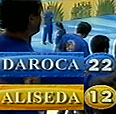 |
|
Made
in Colour • This programme may exist in Spanish Archives |
|
|
|
E |
Grand Prix del Verano
2005 |
Final |
|
Event Staged: Summer 2005
Venue:
Estudio L-3 (Studio L-3), Estudios Buñuel (Buñuel Studios),
Avenida de Burgos, Chamartín, Madrid, Spain
European Transmissions (Local Timings):
TVE La 1 (E): Sunday 11th September 2005
Audience Figures:
TVE La 1 (E): 1,490,000 viewers / 16.8% share |
|
Teams:
Carrión de los Condes (Palencia) v. Ribera Alta (Álava) |
|
Team
Members included:
Carrión de los Condes (Palencia) - David Bustamante (Team Patron);
Ribera Alta (Álava) - Lucrecia (Team Patron). |
|
Game
Results and Standings |
|
Result |
Team |
Points |
Final Scoreboard |
|
1st
2nd |
Carrión
de los Condes (Palencia)
●
Ribera Alta (Álava)
● |
32
26 |
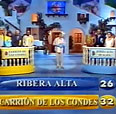 |
|
Made
in Colour • This programme may exist in Spanish Archives |
|
|
|
JSFnetGB Series Guide pages researched by
Neil Storer and
Alan Hayes
with Ischa Bijl, Julien Dessy, Sébastien Dias, David Hamilton, Denis Kirsanov, Paul Leaver, Philippe Minet,
Christos Moustakas, David Laich Ruiz, Marko Voštan and JSFnet Websites |
|
|